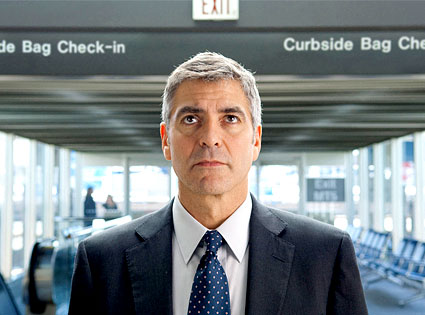Rating: ***
Topical yet solid, the recession comedy Up in the Air (2009) is pretty shameless in exercising its sentimental grip. Thank heavens (or skies), that grip is firm enough. The script is all winks on one hand, and all Capra-sermonizing on the other. Sneers are the padding for the final upbeat message that – once launched – still makes a palpable ideological thud.
This pro-family romantic comedy, flirting heavily with social realism (and even becoming documentary at some points) gets away with its preaching by way of cleverness of characterizations. The central trio of characters – played by George Clooney, Vera Farmiga and Anna Kendrick – flaunt their technocratic mindsets so unflinchingly that it works as a sort of preemptive strike at the audience. In a movie in which the bar-pick-up-line is “Are you satisfied with your Maestro?”, there are no limits of outrage left to be crossed. Instead, there’s the gradual undermining of outrage and exposing its secret lining (i. e. the characters' derision).
Stylistically speaking, Jason Reitman (the only director to have found his baddie in Jason Bateman) is close to hackdom. Many of the scenes in Up in the Air have the rapidness of habitual card-swipes (in fact, many shots depict just that): their function is pretty much their subject. More often than not, instead of working out a clever choreography for a scene, Reitman relies on editing instead: a sad case of Clooney’s airport ballet, which smoothness is entirely based on cutting, and not on the actor’s movements.
And yet there’s one thing to be said about Reitman, the director: he knows how to relish in the constant flow of dialogue – how to make talk glitter. He’s one of the very few American directors working nowadays who can make inflections and rhythms of speech so exciting. He’s into smooth-talkers, as he’s shown in Thank You for Smoking (2004), and into wisecrackers – no better example for that than Juno (2007). But Up in the Air is a rare case of a movie that has several characters who challenge each other’s wits – and that’s something American cinema was great at; 70 years ago. Good to see it back; however brief the visit.
PS. Anna Kendrick – a tougher and more angular version of Amy Adams – is especially impressive: hers is the only character who puts helplessness on display in spite of herself (the long scene of firing a guy over Skype is her tour de force).






Hi Michal,
ReplyDeleteI read that Reitman used real people who got fired to play in this film. I thought that collectively there were another protagonist of this story.
Craig's Anna
Hi Mrs. Scanlon!
ReplyDeleteAgreed. That's what I meant by the movie's flirt with documentary (actually, this footage was pretty powerful).
Say hi to Craig, I hope the notorious homewrecker Julie P. didn't manage to drive him away from Dąbrowa Tarnowska! :)
--Michał
I'm so glad I waited with reading your review until I actually saw the movie. The part about contemporary American cinema lacking characters who challenge each other's wits reads bullshit all over, though only "Thank You For Smoking" and - on a different level - "Solaris" come to mind off the cuff (ommitted "Wit" due to it being a bit on the nose, and based on a theatre play :)). I'm glad we at least agree on the firing scene though.
ReplyDeleteI wanted to become a Vera Farmiga to your George Clooney and come up with something clever, but sadly I lack the intellectual chops for that :) Still, it's nice to see us actually finding even the slightest ground we can agree on. And remember: nobody bites mama.
ReplyDeleteI never know exactly how smug your self-deprecation is :D
ReplyDeleteBelieve me, it's no smug at all :) I save all my smugness for all-out bragging rants that I occasionaly serve to my crowd after a third beer. Stick around sometime, I'll out-smug the hell out of you :)
ReplyDelete